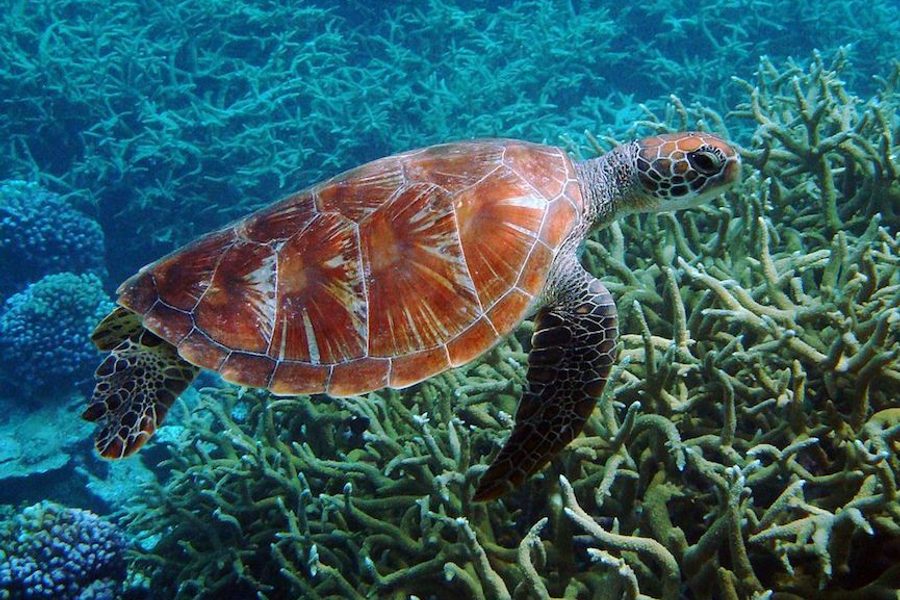Reef Madness: The Trump Administration’s Plan To Hand a Coral Ecosystem to the Fishing Industry
Sasha Kramer

In April 2017, President Donald Trump signed an executive order directing Interior Secretary Ryan Zinke to produce the review, declaring that America’s network of national monuments is the result of “an egregious abuse of power” and “a massive federal land grab.”
Zinke’s ensuing review proposes changes to 10 monuments: It recommends that the size of four be reduced, and that economic activity, such as commercial fishing, mining and logging, be reinstated in another six. Even before the final review was released Dec. 5, 2017, Trump began to take action on these recommendations, cutting Bear Ears National Monument by 85 percent and shrinking Grand Staircase-Escalante National Monument to half of its original size to pave the road for oil and gas exploration.
Zinke’s recommendation also issues an equally dangerous attack on marine monuments in both the Pacific and Atlantic Oceans. He recommends shrinking the Pacific Remote Islands Marine Monument, a network of islands and atolls that forms the world’s largest marine reserve at nearly 500,000 square nautical miles. Zinke also advocated that the commercial fishing ban in the monument’s waters be revoked.
Currently, commercial fishing is banned in the ocean area that extends out to 200 nautical miles from the islands’ shorelines. Zinke prescribes a transfer of management of the monument from the National Oceanic and Atmospheric Administration (NOAA) to the historically corrupt Western Pacific Regional Fishery Management Council (Wespac), which currently oversees a vast territory of 1.5 million nautical square miles.
Trump has not yet acted, but conservationists are concerned that Zinke’s recommendations could spell disaster for the monument, and worry that Wespac would privilege commercial fishing over the needs of the ecosystems.
“I’m not aware of any entity that is as consistently anti-conservation as Wespac,” says Paul Achitoff, a Honolulu-based environmental attorney.
Wespac’s Corporate Agenda
The Pacific Remote Islands Marine Monument, located about 1000 miles from Hawaii, is home to more than 300 species of fish and 100 species of coral. The monument serves as a sanctuary for aquatic endangered and depleted organisms, including sea turtles, pearl oysters, giant clams, reef sharks and coconut crabs.
Bob Richmond, a coral reef biologist at the University of Hawaii at Manoa, tells In These Times that the islands were selected to receive protection in part because of climate change. The Western Pacific Warm Pool—a migrating body of warm water in the open ocean — is projected to push species of fish towards the Pacific Remote Islands, Richmond explains, and thus the region will be an important refuge.
For nearly a decade, commercial fishing has been banned in the monument’s waters. In 2009, President Bush inaugurated the islands as a national monument and protected the monument’s waters out to 50 miles from the islands’ shores. In 2014, President Obama expanded that territory and fishing ban to cover the 200 nautical miles of sea that circle the monument’s islands.
Longline fisheries present a major threat to the Pacific Remote Islands. As the name suggests, longline fishing is a technique employed by commercial fishers, in which 10-kilometer lines holding thousands of baited fishing hooks are let out to drift for hours or days. Longliners catch not only the targeted fish, but also larger animals like seabirds, turtles, sharks and whales. “One of the issues with the longliners is that they were catching basically one shark for every two bigeye,” says Richmond. “We know apex predators, like sharks, are very important in maintaining the stability of ecosystems like coral reefs.”
This stability has helped the islands evade the global trends of coral mortality. The ecosystem’s biodiversity enables it to endure and bounce back from the warming and acidification that have devastated reefs elsewhere. All this could change if Wespac is put in charge of the monument’s future.
Longliners face international quotas designed to combat overfishing, and Hawaiian longliners have consistently met these quotas even without access to the marine monuments. (Upon meeting the quota, they have to close down for the year.) But in the past, Wespac has arranged agreements through which U.S. longliners buy up unused quotas from Samoa and Guam, enabling them to restart fishing. If the monument’s commercial fishing ban is revoked, the Hawaiian longliner fleet could quickly carpet the current buffer zone of the Pacific Remote Islands.
The connection between the council and longline commercial fishing industry is seamless. Sean Martin, a Wespac councilmember, is also the president of the Hawaii Longline Association, a trade group that represents the commercial interests of longliners.
In February 2017, Wespac executive director Kitty Simonds solicited the Trump administration to remove fishing restrictions within marine monuments. Invoking Trump rhetoric, a page of her presentation read: “Make America Great Again, Return U.S. Fishermen to U.S. Waters.”
Wespac is funded by grants from the Department of Commerce, and as a federal grant recipient, is prohibited from using federal funds to engage in lobbying activities at both the federal and state level. Achitoff believes that Wespac’s plea to the Trump administration was unlawful: “There’s no question that they did lobby the administration. Their position has been that the law only prohibits legislators. Well I’ve read the laws and my view is that those lobbying laws apply to the executive branch as well as the legislature.”
In recent years, Wespac organized to cut federal protections for green sea turtles, advocated for Hawaii’s fishermen to catch more bigeye tuna than they’re allowed under international agreements, and actively opposed Obama’s expansion of both the Papahānaumokuākeahe Monument and the Pacific Remote Islands. “I’ve never seen any other council take such a consistently strident position against any and all marine protected areas,” said former Wespac member Rick Gaffney to Earth Island Journal.
The Trump administration’s plan to ransack protections from marine monuments is compounded by a bill approved by the U.S. House Committee on Natural Resources in December 2017. The bill excuses some fisheries from annual catch limits and allows fishery councils to overrule monument protections.
But studies show that fishing-free MPAs actually help the fishing economy. Well managed MPAs result in an increase in fish stocks — on average, MPAs see an increase of 446 percent within a decade. This reproduction has a spillover effect, which positively impacts adjacent fisheries. “Marine protected areas are like a bank account that provides interest,” Richmond says. “When the longline fisheries are outside of the 200 mile limit [of the Pacific Remote Islands], they can basically draw on that interest that’s being produced. That’s the key to sustainable fisheries.”
Marine Reserves Are Climate Reserves
In addition to overfishing, climate change ravages the oceans. Seawater absorbs and retains carbon dioxide, which make seawater more acidic, a phenomenon called ocean acidification. Even a small increase in ocean acidity interferes with the way many marine organisms, including coral, produce shells or plates. Increased seawater temperatures bleach and kill coral, while ocean acidification hinders its ability to recover. As a result, as of early 2016, 33 to 50 percent of the ocean’s reefs were seriously damaged or destroyed.
In June 2017, an international team of scientists through the University of York (U.K.) published a study which shows that MPAs help not just ecosystems, but also humans adapt to climate change. For example, the study found that MPAs safeguard coastal communities from sea level rise and grant them more time for adaptation. “We were keenly aware that marine reserves can increase species’ abundance and help alleviate food scarcity, but our evaluation showed reserves are a viable low-tech, cost-effective adaptation strategy,” said Beth O’Leary, a co-author of the paper.
The Pacific Remote Islands serve as ideal scientific laboratories. “We need pristine reefs to see what we’ve lost elsewhere, to better manage damaged reefs and to isolate the effects of climate change,” said Alan Friedlander, a marine conservation biologist at the University of Hawai’i at Mānoa.
If Trump follows through on Zinke’s corporate protectionist agenda it would jeopardize one of the world’s last thriving coral reef ecosystems. Despite their claims, the U.S. fishing economy and U.S. society need MPAs like the Pacific Remote Islands to foster resilience in the face of climate change and overfishing.






